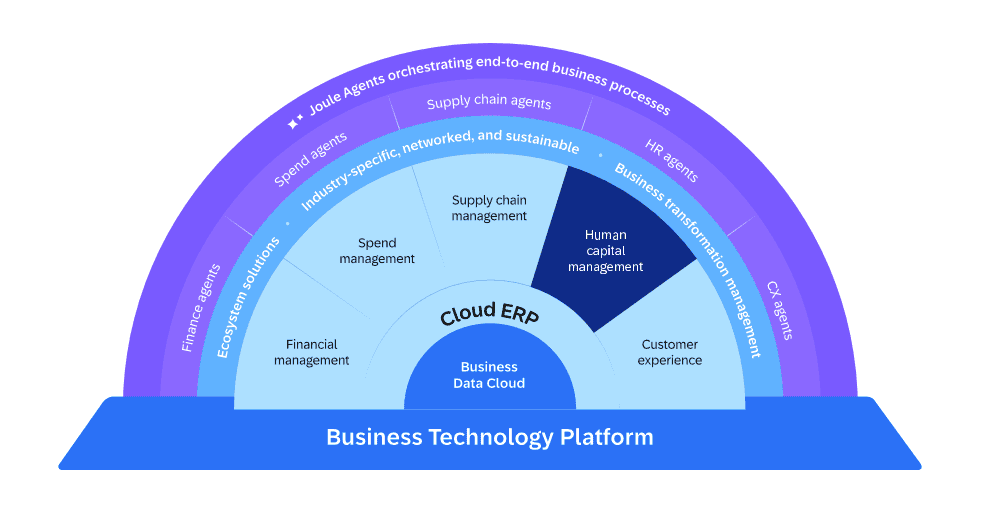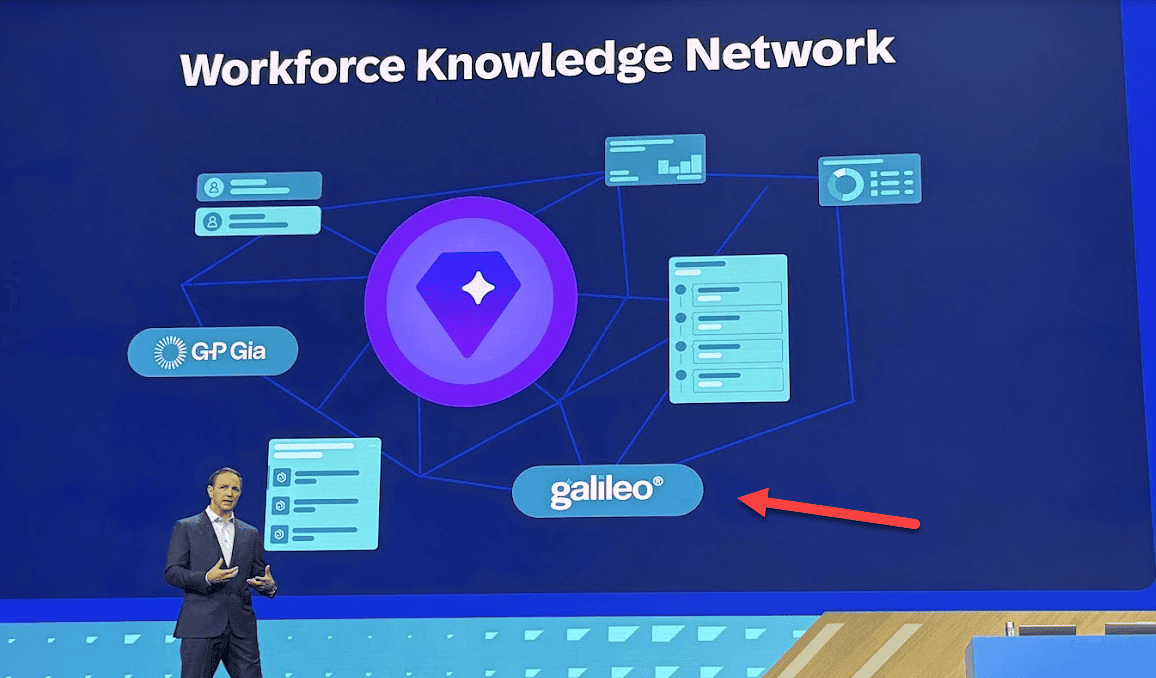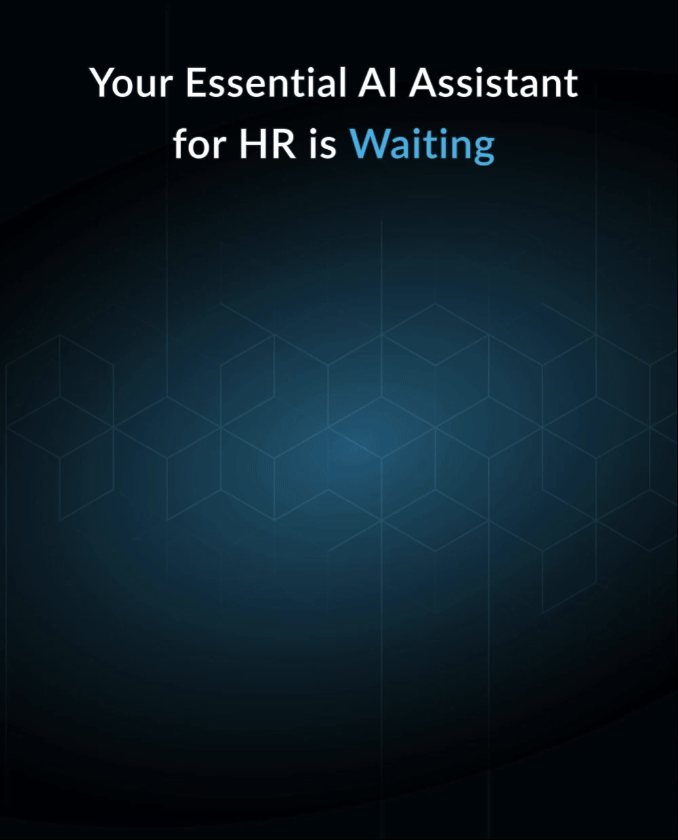SAP Jumps Ahead In AI Agents With Joule, HCM Features, And More
This week we’re at SAP Connect and spent quite a bit of time with Dan Beck, President of Successfactors, the SAP leadership team, and a wide range of SAP Successfactors customers. I have to say, this was one of the most impressive array of enterprise-class AI announcements I’ve seen to date.
SAP Intelligent Enterprise
In many ways SAP is the original inventor (and now leader) in delivering what I’d call “The Intelligent Enterprise.” In other words, every business process in your company is connected together with SAP and for the first time in history, you don’t have to hire an army of analysts to figure out what’s going on. Joule and SAP’s Business AI figure things out for you.
At its core, SAP delivers a set of industry applications (SAP Business Suite) for Finance, Spend, Supply Chain, Customer, and Human Capital Management. These applications (30+ of them) fit together into industry workflows (hire to retire, lead to cash, source to pay, program to operate) which map against all the major value chains in a business.
Within these complex workflows (you can essentially earn an MBA in business by studying SAP), the company has implemented dozens of embedded AI apps to automate, integrate, and optimize these processes. So if you’re a manufacturer and one of your customers places a big order, SAP will tell you that this order may hurt your margins and will intelligently advise to modify the order to use more standard components. And if there’s a hurricane or tariff action that increases the cost of a component, SAP will notify and advise you to reprice your product or source elsewhere.
Imagine a system where all these optimizations (there are hundreds of scenarios) get monitored and optimized in real time. (Imagine your cost of contingent labor goes out of range from overtime: SAP would show you how to increase staff or change shift schedules in detail.) So this AI-based app infrastructure itself is highly intelligent and totally interconnected.
In order to pull this off SAP built its Business Data Cloud, a system that brings data together from all these apps and exposes an SAP dictionary called Datasphere so you can find data in all these apps. The BDC uses SAP technology and also integrates with Databricks and Google Cloud (new).
 |
SAP Joule: The Agent Front Door To All These Systems And More
Now comes the cool part.
On top of these integrated elements sits Joule, and entire AI agent platform that lets users interact with these apps and data elements through chat. Joule is as easy to use as ChatGPT, it supports 40 different AI engines, and it is entirely programmable with Joule Studio. So you can build your own agents in Joule, defining various employee “apps” yourself.
This week SAP launched dozens of these Agents, including five in HR (the Performance and Goals Agent, Career and Talent Development Agent, HR Service Agent, Payroll Agent, and People Intelligence Agent). These are essentially mini-apps for users to do things like help an employee develop or review goals, build a career plan, create or consume learning programs, find answers to HR questions, and manage and reconcile payroll). SAP says that 80% of all core functionality can now be accessed by Joule.
This means that Joule has become the “front door” to your business, making it easy for any employee or business user to find information, analyze data, monitor a team or process, and get advice.

In this latter area we demonstrated the integration of Galileo into Joule, making Joule even more. Starting next year Joule will become an expert HR and leadership assistant (powered by our Galileo), which makes Joule an even more essential AI agent for employees all over your company. (If you’re an SAP customer and you’d like to get Galileo for Joule please contact us or purchase Galileo now and we will upgrade you to the Joule service in 2026).
 |
More In SuccessFactors
There’s even more. SAP also launched a major new system called Workforce Scheduling which delivers smart shift and time scheduling to align labor to demand, match skills, support shift swapping, and many other features. This puts SAP on a collision course with UKG, the leader in complex shift and time management.
And SAP also introduce People Intelligence, a long awaited new product which replaces years of products for People Analytics, with a Joule interface so you can not only monitor skills, engagement, turnover and many other things but get intelligent recommendations to take action on all this data. The HR world has been looking for apps like this for years – so this competes with Visier and similar standalone tools.
Finally, SAP is going after ServiceNow and Salesforce with the release of Enterprise Service Management, an integrated application for call center, case management, incident management, and other service delivery functions. Dan Beck mentioned that he believes this new ESM system extends SAP into HR and customer service in a world-class platform (demo looked good to me!), also connected to Joule.
What Does All This Mean?
Without getting into all the other vendors, let me simply state that SAP has risen the top in HCM functionality, AI architecture, and advanced features for HR and integrated financial management. I’m not saying SuccessFactors does everything (SAP SmartRecruiters makes Successfactors a leader in hiring with AI agents, but tools like Paradox are more advanced in high-volume hiring), but the suite is about as competitive as I’ve seen in years.
Several of the clients I met had switched from Workday to Successfactors because they were SAP enterprise users (IBM, Disney, others). So as I see it SAP is well positioned to win new deals, and the AI architecture is compelling.
When SAP first introduced Joule it was a little unclear where it was going. That’s definitely no longer the case: it’s now becoming a standard front-end for business people and it interoperates completely with Microsoft Copilot and other Agents through the a2a and MCP protocols.
 |
Final Point: New Research Details AI in HR Impact and Case Studies!
My final update on all this progress: we just published a large bundle of research to help you plan and build a business case for AI.
After a year of research today we launched a series of research reports on the Financial Impact of AI in HR, featuring SAP clients. These five in-depth studies look at AI in payroll and time, talent management, employee experience, HR service, and HR operating model (Systemic HR). This research, led by Kathi Enderes, details dozens of real-world use-cases you can learn from.
You can download the infographics here, and if you want to dig into the research just get Galileo and ask Galileo to describe the use-cases and ROI models, look for examples in your industry, or ask Galileo to assess your readiness against all these amazing stories!
(prompt idea: “Galileo, will you give me five examples of AI implementations in recruitment in my industry and what the return on investment was for these companies? Now give me details on the implementation plan and change process they each used?)
PS. Listen to today’s podcast on SAP for an in-depth explanation of Joule and what’s happening with AI Agents in HR.
Additional Information
The Financial Impact of AI on HR: New Research Series
AI Pacesetters: The Six Secrets of AI Transformation Success
Galileo: The World’s AI Agent for HR and Management
Galileo Learn: The World’s HR Academy For Teams
